Have you given ChatGPT a try for producing blog content? It’s a fun AI (artificial intelligence) tool to play around with—and it’s free! Enter: today’s guide to ChatGPT prompts for bloggers.
But one problem that a lot of bloggers have is that ChatGPT seems to produce quite bland, generic content. It’s not the sort of thing they want to publish on their blog.
If you didn’t get the results you wanted with ChatGPT, it may not be because of any of the AI’s limitations. Instead, you might not have been using the best prompts. And in fact, this is one of the top reasons we decided to build RightBlogger, my suite of 80+ AI-powered content creation tools for bloggers (with super SEO-friendly prompts powering all the tools).
In this article, I’ll take you through what makes for a good ChatGPT prompt… and I’ll share lots of my favorite prompts with you, for all kinds of different content types.
27 ChatGPT Prompts for Bloggers (Ideas, Outlines, Blog Posts, SEO & More)
- Beginner’s ChatGPT Tutorial: Everything Bloggers Need to Know
- Writing a Great ChatGPT Prompt
- ChatGPT Prompts to Come Up With Ideas
- ChatGPT Prompts to Craft the Perfect Title
- My Multi-Step ChatGPT Prompt to Write a Full Blog Post
- ChatGPT Prompts to Create an Introduction that Hooks Readers
- ChatGPT Prompts for Your Conclusion and Call to Action
- ChatGPT Prompts for Landing Pages
- ChatGPT Prompts for Marketing Emails
- ChatGPT Prompts for Social Media Posts
- ChatGPT Prompts for YouTube Videos
- 6 Tips and Tricks for Better ChatGPT Prompt Engineering
Disclosure: Please note that some of the links below are affiliate links and at no additional cost to you, I’ll earn a commission. Know that I only recommend products and services I’ve personally used and stand behind. When you use one of my affiliate links, the company compensates me, which helps me run this blog and keep my in-depth content free of charge for readers (like you).
Create SEO Blog Posts in Minutes with RightBlogger
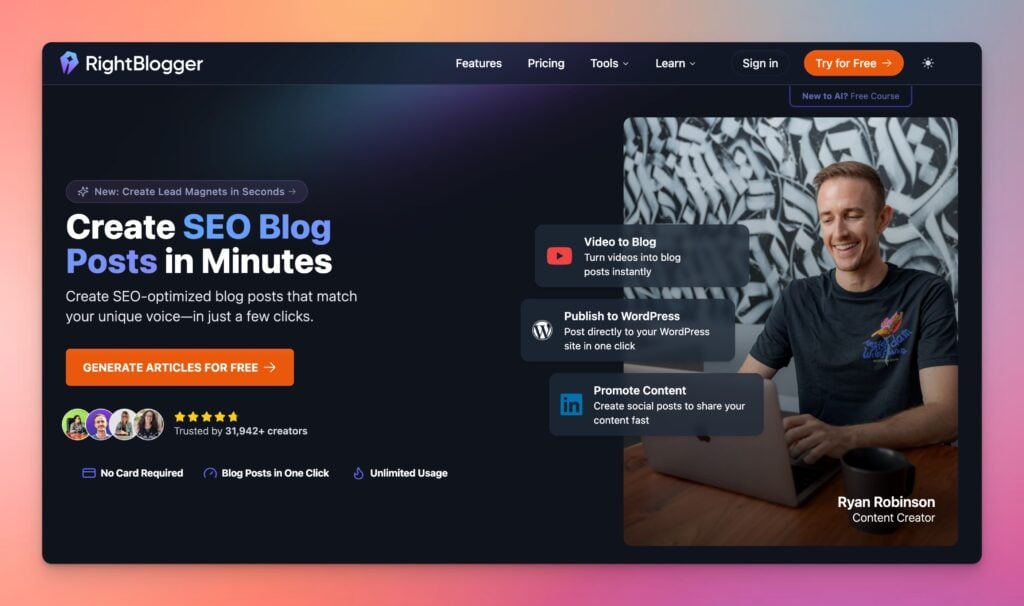
Join 31,942+ creators, bloggers, marketers, writers, freelancers & entrepreneurs in using my very own kit of powerful tools for content creation: RightBlogger. You’ll unlock 80+ blogging, SEO, marketing, sales and productivity-focused tools to create content faster & more effectively today. Plus, you’ll access our library of high-impact courses, a private community, and more.
Beginner’s ChatGPT Tutorial: Everything Bloggers Need to Know
Before we get into the prompts, let’s run through some ChatGPT basics. Don’t worry—I won’t be getting super-technical into the details of machine learning, SQL or JSON coding languages, or obscure metrics you don’t need to know about.
This prompt writing guide is broken down in plain (and I mean plain) English.
I think you’ll also get a ton of value from this deep-dive video where I break down how to construct the perfect ChatGPT prompts (and give you examples of my favorite prompts in action):
Now, let’s dive into our ChatGPT prompt guide for bloggers, content creators & writers.
What is ChatGPT?
ChatGPT is a natural language processing tool that’s powered by AI (artificial intelligence) technology. Peep this guide for more deets on exactly what GPT stands for. You can “talk” to it like a chatbot, and ChatGPT will respond to whatever you ask (your prompt).
ChatGPT can come up with all kinds of content: not just blog posts and social media posts, but also recipes, computer codes, tables of information, and lots more.
ChatGPT is free to use, though there’s also a $20/month premium version (ChatGPT Plus) that gives you faster access. At peak times, the free version of ChatGPT may not be available, but that seems to be few and far between these days.
There are also plenty of competitors these days from Google’s Gemini, X’s Grok, Claude, and Meta’s Llama. These prompts in this post will work in all of these services since they offer similar capabilities.
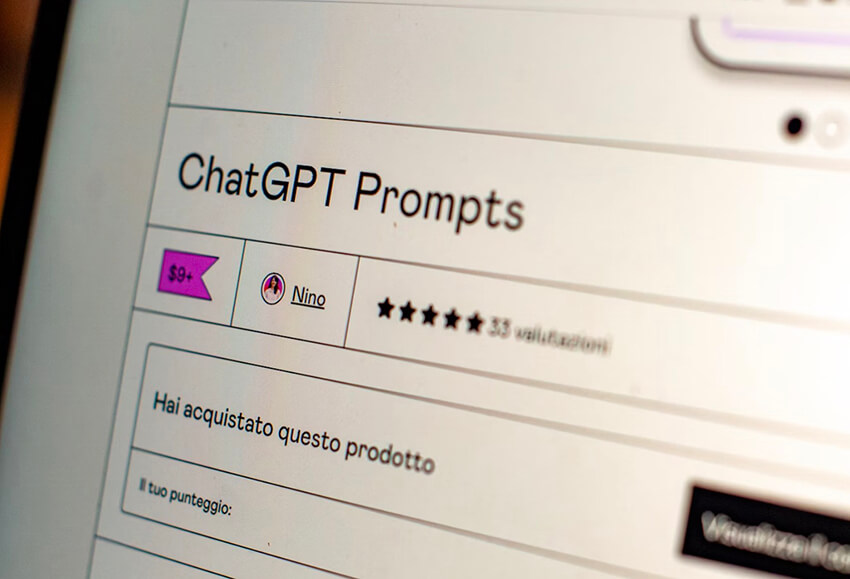
The company behind ChatGPT is called OpenAI, an AI research and development company. They’ve made the underlying system for ChatGPT available for other companies to use through the OpenAI Chat API.
Understanding GPT-3, GPT-4, and GPT-4o
When ChatGPT was first released in November 2022, it was using the GPT-3 language model. But OpenAI also developed GPT-4, and they released GPT-4 AI model in March 2023. OpenAI has fine-tuned their GPT-4 model with the introduction of GPT-4o and GPT-4o mini which primarily power ChatGPT now. I can’t wait to see the possibility of GPT-5 being released in 2025.
GPT-4o, the most current and up-to-date model from OpenAI has more parameters, is designed to accomplish more advanced and creative tasks (including creating music and art), and can accept multimodal input like images, not just text input. GPT-3.5 only handled text-based input and output.
What Else Can ChatGPT & Similar AI Tools Do?
In this article, I’m focusing on every day uses of ChatGPT for blogging (and influencers), like coming up with blog post ideas, writing blog posts, and creating social media content. Head over here if you’re looking more for writing prompts that’ll get your creative juices flowing.
But if you’re a programmer or artist, there’s a lot else ChatGPT can do too through the power of machine learning and its huge dataset. You might take it to the next level by using it to:
- Write or debug computer code (e.g. Javascript, Python, or other programming languages)
- Craft prompts for image AIs like Midjourney and Dall-E 3
- Create Excel formulas
- Come up with unique recipes
- … or all sorts of other things!
You can also use ChatGPT for personal tasks, like coming up with the perfect road trip playlist, rewriting a sentence or paragraph to avoid plagiarism, or getting a great list of ideas for family movie night.
Writing a Great ChatGPT Prompt (My Formula)
Writing a ChatGPT prompt is simple—though writing a really good prompt requires a little more effort.

From a blogging perspective, any basic (great) ChatGPT prompt should include these six elements:
- Task: This one is straightforward. Tell the AI what you need. It could be writing an intro, drafting a blog post, or generating ideas.
- Context: Give as much background and detail as possible at this stage. The more specific you are, the better. Let the AI know details that are important to the task (like what your take is on a subject you’re writing about).
- Exemplar: Just a fancy way of saying “example.” Explain to ChatGPT exactly what kind of output you’re looking for. Including real examples will help it get closer to what you envision.
- Persona: Who should the AI “be” while writing this content for you? Imagine that AI can wear different hats for different tasks. Explain who it is within your prompts, and it’ll have a much better understanding of how to go about creating your output.
- Format: Share which format you want the final product to come in. What exactly should the AI output look like? Do you want a list, a paragraph, a blog post with multiple sections, maybe just some bullet points? Be specific here.
- Voice: Always define the style and tone when you’re writing a ChatGPT prompt. Do you want your output to be casual, formal, playful, something much more nuanced? Let these tools know, so your writing outputs will match your vibe.
To illustrate the difference between a basic ChatGPT prompt (just 1 or 2 short sentences of instructions) vs a highly detailed, multi-step prompt with ultra clear instructions about what exactly we want the AI to create, let’s look at this comparison example.
Here’s an example of a very basic ChatGPT prompt that a lot of new AI creators often use:
On the surface, it seems pretty good, right? We’ve got the type of content, topic, and word count. So, let’s see what happens with this example:
ChatGPT will take any prompt you give it—even a very basic one and do it’s best to produce a full on blog post:
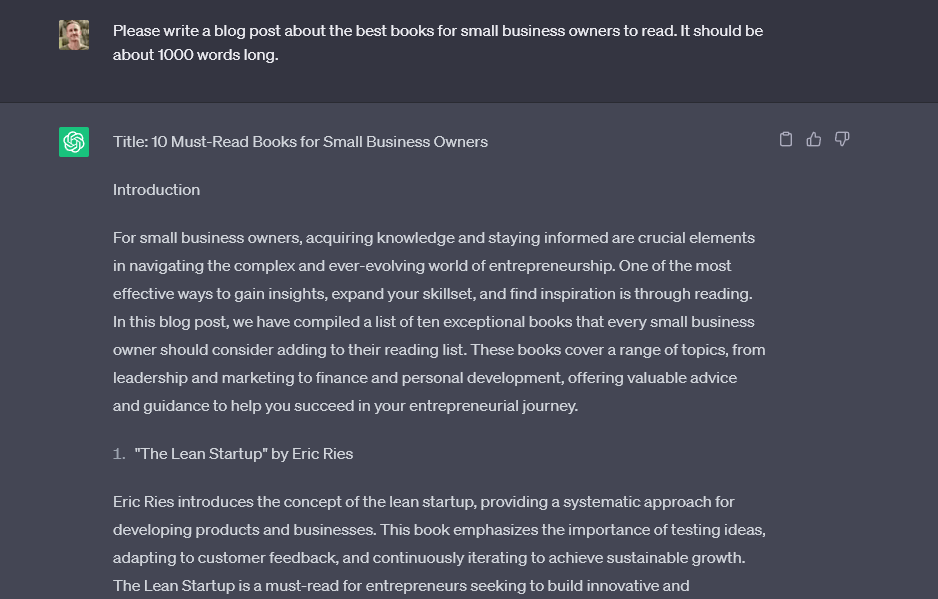
You could be happy with this result, but I’m not. It seems pretty competent, grammatically correct, and feels informative.
You may also feel it doesn’t read as well as you’d like. The introduction is a bit wordy and perhaps you’d like to fine-tune the list of books rather than just letting ChatGPT pick. I’d argue this output is also pretty bland, lacks a strong stance on the topic, and doesn’t sound like me in the style & tone department.
In short, it feels like AI wrote this (it did), but the real art in prompting ChatGPT to get truly great outputs, lies in highly detailed prompts… which we’ll dive into here in this guide below.
Here’s an example of an output from my highly detailed, multi-step ChatGPT prompt for writing a version this blog post so you can see the difference that detailed prompting can make (this full copy & paste prompt and more details about it can be found in the list below):
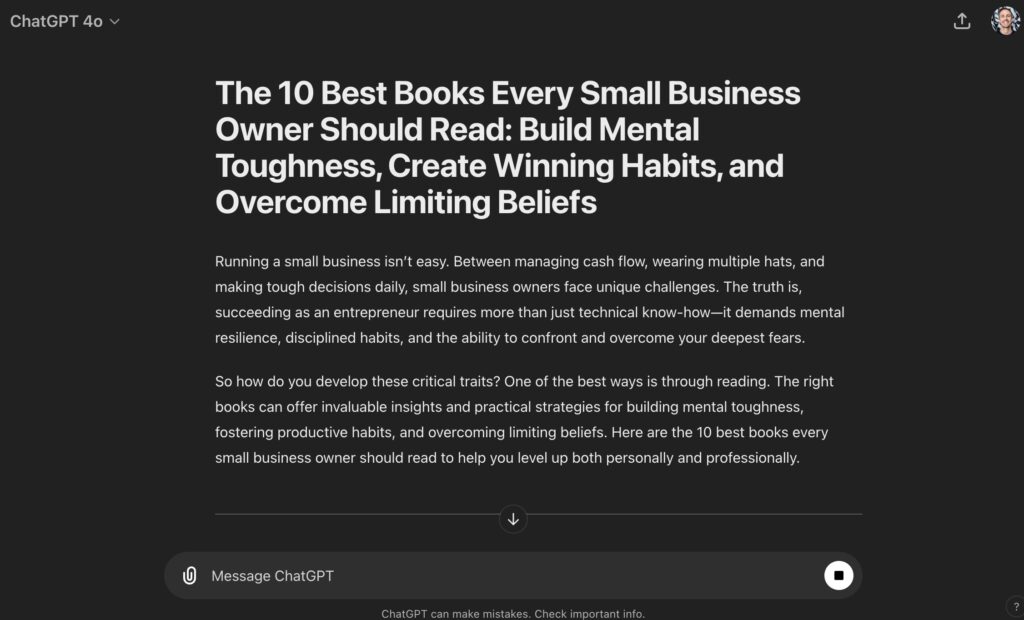
As you can see, this ChatGPT output is clearly set up to be a much stronger first draft blog post. We’ll go into more detail below.
Now, let’s dig into my most popular and effective ChatGPT prompts for bloggers across different use cases—before taking a look at how to better engineer your ChatGPT prompts.
27 ChatGPT Prompts for Bloggers (Ideas, Outlines, Blog Posts, SEO, and More)
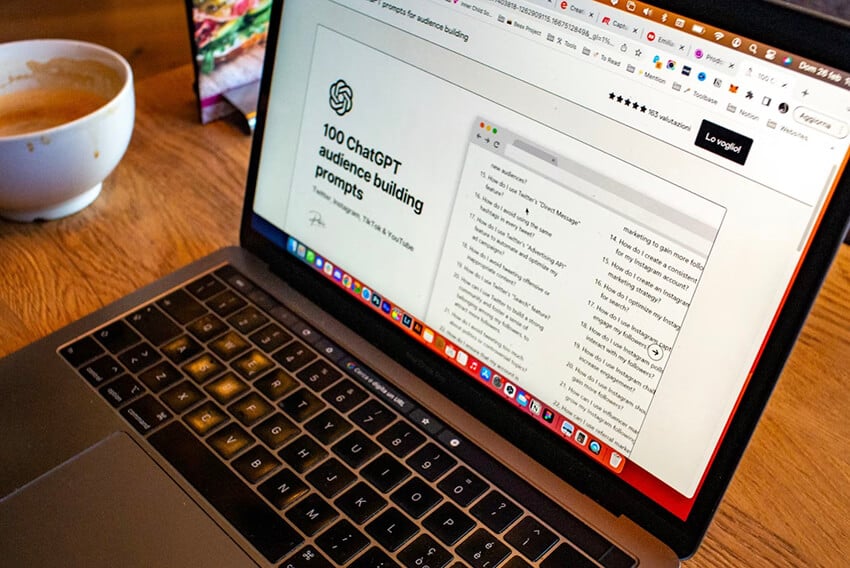
I’ve broken these blogging-specific ChatGPT prompts down into sections, based on how to best utilize them.
ChatGPT Prompts to Come Up With Ideas
What if you don’t even know what you want to write about? ChatGPT can help you there! Here are some great prompts to use when you’re looking for blog post ideas to write about, for a variety of different use cases.
1. Idea Generation Prompt
2. Niche Selection and Validation Prompt
3. Product Promotion Idea Generator Prompt
ChatGPT Prompts to Craft the Perfect Title
Maybe you’ve got an idea in mind or you’ve even written a full post. Coming up with a great SEO title or headline can be challenging. You want something that will resonate with readers while working well for search engines too.
ChatGPT can help you a lot here. Try these prompts.
4. Blog Headline & Title Generation Prompt
5. Title Improver Prompt
6. SEO-Driven Title Creation Prompt
My Multi-Step ChatGPT Prompt to Write a Full Blog Post
Getting ChatGPT to write a full blog post that’s a genuinely great first draft requires upfront effort in the prompting process, there’s no way around it. Other software that uses ChatGPT’s underlying GPT framework may include special tools to help you get a full blog post, just like we do inside RightBlogger’s Article Writer tool (and my free AI article writer here too).
I have an entire guide to my personal AI blogging process that goes deeper on my thoughts around how to best utilize tools like ChatGPT and RightBlogger to write blog posts with the help of AI—but the key takeaways are two things:
- Treat AI-generated blog posts as first drafts: We’ve all seen the imperfection of AI on full display more times than we can count, and nothing is more true than if you give AI very little direction to work with, it’s going to be wildly unpredictable in its output. The more guidance you give it (in the form of a detailed prompt), the better your first draft will be, but it’ll always be a first draft, because…
- Weave as much of yourself & your take into the creation process as possible: AI doesn’t have a lived body of human experience, it can’t draw on the real examples inside your head, and it won’t be able to tap into your human emotion. It’s an imitation of all these things, and in that sense it’ll always be non-human. Full articles from sources like ChatGPT and RightBlogger can be pretty impressive, but they still need your editing, your style, real-life examples, stories, and personal experiences.
7. Entire Long-Form, SEO-Optimized Blog Post (Draft) Prompt
The first step to writing an SEO-optimized first draft article that uses real-time Google search data, is crafting a great outline.
Step 1: Generate a detailed, SEO-optimized outline for ChatGPT to use:
Here’s step one of writing a full blog post draft using ChatGPT, focusing in on creating a very strong outline first:
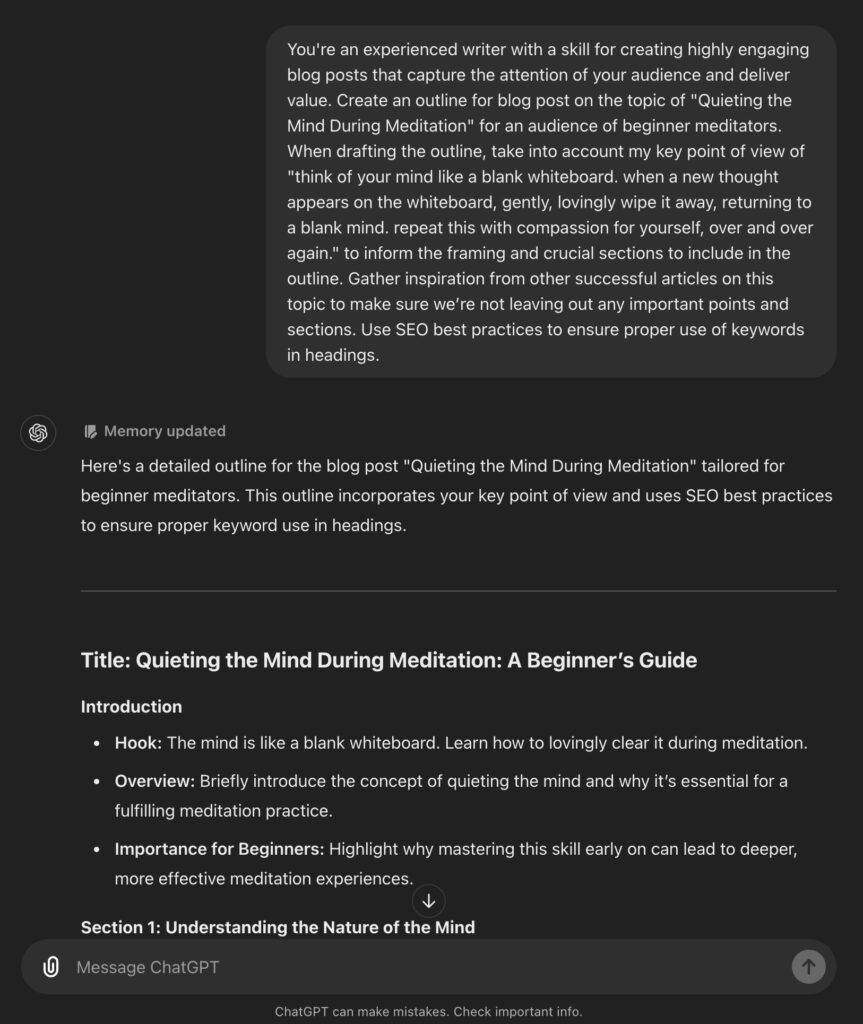
Step 2: Make edits to refine your outline.
Interact with ChatGPT to make any necessary edits and revisions to the outline you’ve created.
Please don’t skip this step, it’s crucial to making sure you’re injecting your take, beliefs, style, personality, and experience into the AI writing process. Without you, I can promise your ChatGPT outputs will sound more like AI and be a total pain to level up during your editing process.
Step 3: Write the full first draft of your article using the tuned up outline you’ve created.
And here we go—here’s a preview of what ChatGPT’s doing with this prompt. Not bad, but could use a whole lot of love in the formatting department:
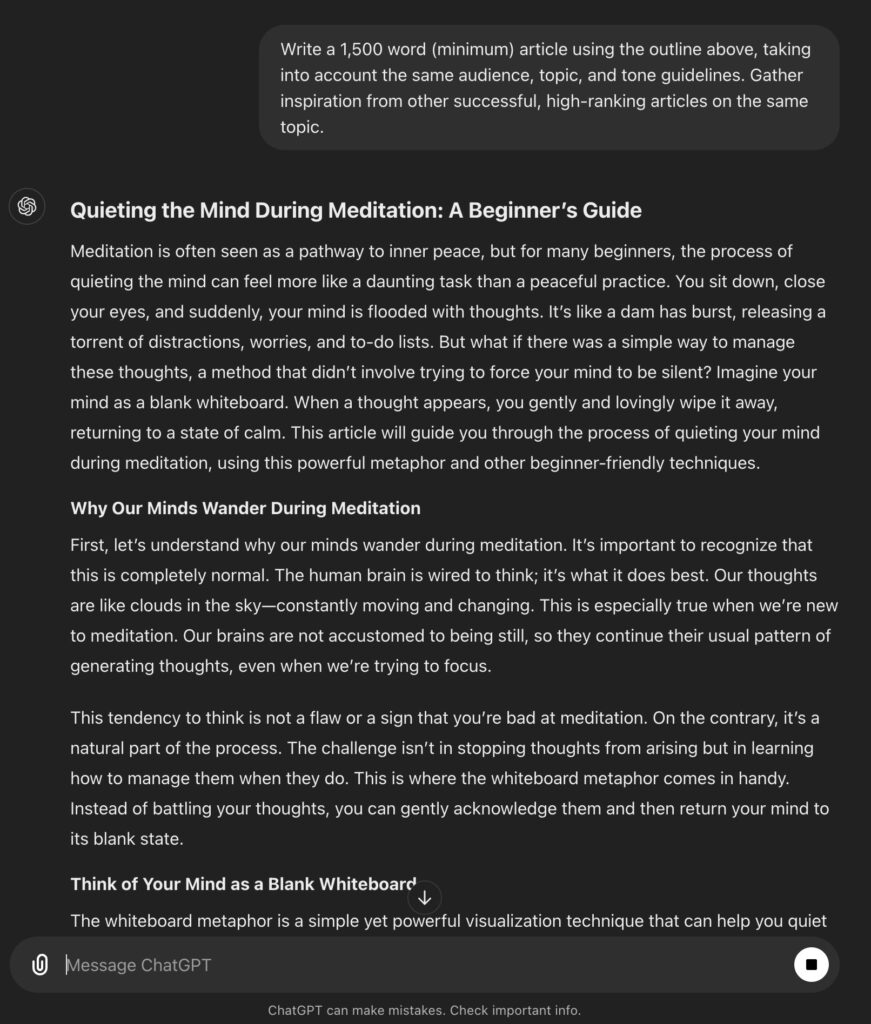
This process is kind of a lot, I know. Simplify your AI writing experience by using my free AI article writer. For a super-powered version of this tool, you’ll wanna use RightBlogger’s Article Writer, where we’ve really dialed things up about a hundred notches.
Create SEO Blog Posts in Minutes with RightBlogger

Join 31,942+ creators, bloggers, marketers, writers, freelancers & entrepreneurs in using my very own kit of powerful tools for content creation: RightBlogger. You’ll unlock 80+ blogging, SEO, marketing, sales and productivity-focused tools to create content faster & more effectively today. Plus, you’ll access our library of high-impact courses, a private community, and more.
8. How-To Blog Post Prompt
Swapping in some of these details below into the multi-step creation process above, here’s a ChatGPT prompt for a how-to style blog post:
9. Listicle Blog Post Prompt
Again, taking these adjusted details in order to generate a list-style blog post, apply these tweaks to the multi-step process above and you’ll get a stellar listicle blog post from ChatGPT:
ChatGPT Prompts to Create an Introduction that Hooks Readers
What if you’ve already got a blog post that you want to improve—or you’ve written the bulk of your post and you just need an introduction? With the right AI prompts, you can create introductions that hook readers’ attention and draw them into your content.
10. Question-Driven Introduction Prompt
11. First-Person Authoritative Introduction Prompt
12. Short, Punchy Introduction Prompt
ChatGPT Prompts for Your Conclusion and Call to Action
It can be tricky to know how to end a blog post and some bloggers just—stop. They end with their final “how to” step or the final item in a listicle.
This is a huge wasted opportunity. Your post’s conclusion is a chance to round things off and prompt the reader to take action. Not sure how to write it? ChatGPT can help you here.
13. Comprehensive Conclusion Prompt
14. Short Conclusion Prompt (with Multiple Options)
15. Personal Reflection Conclusion Prompt
ChatGPT Prompts for Landing Pages
ChatGPT is incredible for writing blog posts… but what about sales content? If you’ve created a product to sell from your blog, one big challenge you’ll face is writing the landing page or sales page for it. If you don’t have marketing experience, this can feel like a huge hurdle. If that’s the case, be sure to snag all of my best ChatGPT prompts for marketing, too.
Once again, ChatGPT can give you a huge helping hand, with these landing page prompts.
16. Free Lead Magnet Landing Page Prompt
17. Product Sales Landing Page Prompt
18. Online Course Sales Landing Page Prompt
ChatGPT Prompts for Marketing Emails
Once you’ve got a landing page, it’s time to promote your product. It can be tricky to know what to write, though, especially if you’re used to creating blog posts rather than sales emails. ChatGPT can put together plenty of effective emails for you, using these AI chatbot prompts.
19. Product Marketing Email Prompt
20. Early Bird Preview Marketing Email Prompt
21. Product Sale Marketing Email Series Prompt
ChatGPT Prompts for Social Media Posts
Social media can be an incredibly valuable marketing tool for your blog and online business … but it can also become a huge time sink, especially if you want to maintain an active presence on multiple social platforms. ChatGPT to the rescue! Try these prompts for done-for-you social media content: ChatGPT will even include emojis and hashtags.
22. Tweets (X Posts) Prompt
23. LinkedIn Posts Prompt
24. Instagram Post Ideas Prompt
ChatGPT Prompts for YouTube Videos
Many bloggers also have a YouTube channel—and while this can be an effective way of getting more traffic, it can also be a lot of work. Get ChatGPT to come up with ideas and write your scripts for you, and you’ll be able to dramatically cut down the time you’re spending making videos.
25. YouTube Video Ideas Prompt
26. YouTube Video Script Prompt
27. YouTube Video Outline Prompt
6 Tips and Tricks for Better ChatGPT Prompt Engineering

How can you get more from ChatGPT’s algorithm? Whether you’re tweaking my prompts or coming up with your own, here are some ways to use the AI powers of ChatGPT to the full.
1. Make Your Prompts More Detailed
The more detailed your prompts are, the better ChatGPT can respond. Try telling ChatGPT about your audience, adding details of your existing content (e.g. if you’re creating a landing page for an app you’ve created), or fleshing out what exactly you’re looking for in the response (e.g. “step-by-step instructions” or “summarize this content”).
2. Tell ChatGPT What Tone or Voice You Want
By default, ChatGPT’s responses may seem a bit bland and business-like. But they don’t have to be! Just tell ChatGPT what tone you want. (Note that it won’t use swear words, even if you ask it to: if that’s a hallmark of your style, you’ll need to add them yourself.) You can also ask it to “rewrite that” in a specific style, if a piece didn’t come out quite how you wanted.
3. Ask for a Specific Word Count
Whatever type of content you’re creating, it’s worth specifying a word count. Otherwise, ChatGPT might produce something much longer or shorter than you were expecting. You can also ask ChatGPT to tell you the exact word count for a whole piece or even individual sections.
4. Get ChatGPT to Expand on Its Answers
One of the best things about ChatGPT is that it remembers what it’s already discussed with you in a chat. So, if an answer is a bit short, you can ask ChatGPT to expand on it or add something extra. For instance, if ChatGPT has just come up with a list of blog post titles, you could ask it, “For each title, please write a meta description” or “For each title, give me a list of bullet points to include in that post.”
5. Always Fact-Check the AI’s Output
Sometimes, ChatGPT will make up incorrect facts and statistics—and it will even add references to imaginary articles, if you ask for sources. It’s important to always fact-check the content you produce using ChatGPT. Make sure that facts and figures are backed up by a verified and reliable source.
6. Use a Specialist Blogging Tool (E.g. RightBlogger)
It can be a lot of work to fine-tune your prompts for ChatGPT to write a blog post with AI—and if you want lots of different types of content, you could end up spending hours getting your prompts just right. A much quicker way is to use specialist AI software such as RightBlogger, which has lots of built-in tools powered by OpenAI’s GPT model.
Key Takeaways: Use My ChatGPT Prompts to Supercharge Your Blog
ChatGPT is a fantastic tool for bloggers—but it can take a bit of work to get the most from it. My prompts above should help you come up with some incredible content in a fraction of the time it’d take to write it … but you can also use the tips and tricks to modify these prompts or create your own.
And because AI is integrating so deep into the world of blogging, check out all of my top free AI blogging tools & guides:
- Free AI Article Writer Tool (AI-Powered) SEO Blog Posts
- Free Blog Idea Generator Tool to Get Unlimited Blog Ideas
- Free AI-Powered Blog Title Generator for Creative Headline Ideas
- Free Keyword Research Tool for Bloggers, Writers & Content Marketers
- Free AI Paragraph Rewriter Tool (to Reword Your Paragraphs)
- Meta Description Generator to Write Smart SEO Descriptions
- AI Blogging Guide: How to Use AI for Your Blog (Thoughtfully)
- 16 Best AI Blogging Tools to Use This Year
- 14 Best AI SEO Tools for Bloggers to Get More Search Traffic
- 23 Top AI Tools and Apps for Content Creators
- 15 Best AI Writing Tools for Bloggers and Writers
If you’re finding that creating prompts is taking too much time or you’re not getting the quick and easy results you want, check out RightBlogger. It’s powered by the same technology behind ChatGPT, but with custom-made blogging tools, SEO tools, social tools, e-commerce tools, and more so you can get the exact results you want.
Create SEO Blog Posts in Minutes with RightBlogger

Join 31,942+ creators, bloggers, marketers, writers, freelancers & entrepreneurs in using my very own kit of powerful tools for content creation: RightBlogger. You’ll unlock 80+ blogging, SEO, marketing, sales and productivity-focused tools to create content faster & more effectively today. Plus, you’ll access our library of high-impact courses, a private community, and more.

38 replies to “27 ChatGPT Prompts for Bloggers (Ideas, Outlines, Blog Post Drafts, SEO, and More)”
Thank you for sharing this invaluable resource! These prompts will undoubtedly help bloggers elevate their writing and connect more effectively with their audiences.
Really amazing blog , really loved reading!!
Thank you for sharing this invaluable resource! Thanks Sir
Thanks for writing this comprehensive blog including almost everything that is needed. It will surely help.
Nice article on ChatGpt. Got information about this in detail.
🙏
Great article
Your article has been incredibly helpful to me.
🙏☺️
thanks for this article,it is very usefull for me.
When I open ChatGPT, I also open this article
nice! I love to hear that. Glad you’re finding these prompts so useful, my friend!
Fantastic resource for bloggers! These prompts are perfect for boosting creativity and tackling writer’s block. I especially love the focus on SEO—so important for an SEO services agency. Excited to try these out in my writing! Thanks for sharing!
Nice article on ChatGPT prompt. Very informative.
Thank you for sharing this valuable information article!
Thanks for detail article about ChatGPT.
These prompts are incredibly useful for bloggers! At iflair.com, we appreciate how AI can inspire fresh ideas and improve efficiency in content creation. Looking forward to trying some of these out—great job compiling them!
This list is an absolute goldmine for bloggers in 2025! The way ChatGPT can instantly turn a simple idea into a full draft or SEO-optimized content is game-changing. I’ve already bookmarked a few prompts for brainstorming and writing intros — saves so much time! Thanks for breaking it down so clearly